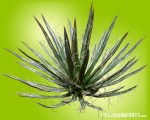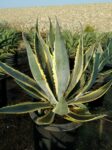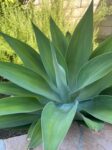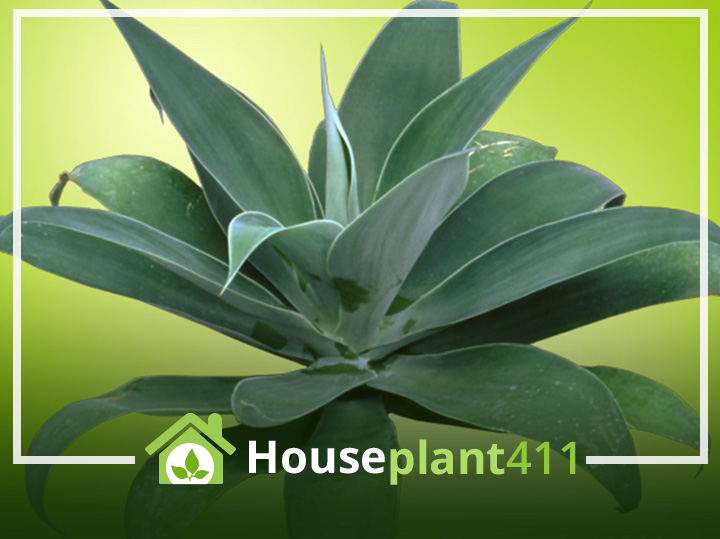About
The agave plant was originally found growing in Mexico, the southwest United States, and central South America. This is an impressive looking, succulent plant that grows well both indoors and outdoors. Because some varieties have spines on the edges of their leaves, many people have the misconception that an agave plant is a type of cactus; but it isn’t; it’s a member of the Asparagaceae family and is closely related to a lily and an amaryllis plant.
Description
An agave plant comes in all different sizes and shapes; some are extremely large and belong growing outside while the smaller varieties make perfect indoor potted houseplants. Agave plants are succulents with multi-layered rosettes of thick, fleshy, leaves. The short, thick stem is often hidden by the large, leathery leaves. If there are children and pets in the house, avoid purchasing agave plants that have sharp, pointed leaves with spiny margins. The sap in the agave leaves is very irritating and the spines and sharp points are painful if they puncture your skin. It takes many, many years for an agave plant to flower, especially when grown indoors. Some varieties may eventually produce a very tall stalk with clusters of flowers at the top. You may not want your agave plant to bloom since, strangely, they often die after flowering.
Agave Plant Varieties
There are over 450 varieties of agave plants. When selecting a plant for your home, choose one that will not outgrow your room. Here are some of the most popular:
Agave attenuata (Foxtail Agave)
Agave Americana (Century plant)
Agave Queen Victoria
Agave Filifera
Agave Verschaffeltii




A. Filifera A. Verschaffeltii A. marginata Americana A. Foxtail
Quick Care Tips for an Agave Plant
Indoor agave plants need very bright light and even some direct sun
Over watering is the easiest way to kill an agave plant
No need to mist just provide good air circulation around the plant
Do not rush to repot
Easily propagated using the offsets that grow around the base of the plant.
Yellow leaves mean the plant has been over watered and the roots are damaged
Is an Agave Plant Poisonous
The sap of an agave plant causes skin irritations and the sharp, pointed tips and serrated edges on the leaves can cause painful sores. Read more about common houseplants that can be dangerous in my book Don’t Feed Me to You Cat: A Guide to Poisonous Houseplants
Plant Care
Light
How much light for an agave plant: An indoor agave plant needs all the bright light it can get to grow well indoors. Place the plant in front of a south or west facing window if possible.
Water
How to water an agave plant: These are very drought resistant plants and the easiest way to kill an agave plant is by over watering, especially in the winter. During the spring and summer, water when the tops few inches of soil has dried out. In the fall, water every 2-3 weeks. During the winter, water about once a month.
Fertilizer
How to fertilize an agave plant: When immature, an agave plant should be fed monthly, in the spring and summer, with a balanced plant food diluted to 1/2 the recommended strength. Do not fertilize at all during the fall and winter. Once an agave plant is three or four years old, it doesn’t need to be fertilized at all.
Temperature
Best temperature for an agave plant: Warm temperatures above 65° and as high as 80° are perfect for an agave plant. Avoid placing it near cold winter drafts or in front of an air conditioner.
Humidity
Does an agave plant need high humidity: This drought resistance plant thrives in warm, dry air and suffers when it is too humid.
Flowering
Does an agave plant flower: This plant may flower after many, many year. It will produce a tall spike with a cluster of flowers at the top. However, many times the plant dies right after it flowers.
Pests
Agave plant pests: Mealy bugs and scale can be a problem.
Diseases
Agave plant diseases: The most serious problem is root rot caused by over watering. This fungal disease can quickly kill the plant. Immediatly get rid of the wet soil and allow the plant to sit out, bare root, for 24 hours. Repot in fresh dry soil.
Soil
Proper soil for an agave plant: Use a succulent potting soil or any good, loose, fast draining indoor potting mix.
Pot Size
What size pot for an agave plant: Use a shallow pot with drip holes in the bottom so excess water can escape. The width of the container should be a few inches wider than the width of the plant. An agave is a slow growing plant and should not be moved to the next size pot, and nothing larger, until the roots of the plant have filled the existing pot.
Pruning
Does an agave plant need pruning: The only time an agave plant needs to be pruned is if there are dead or dying leaves on the plant. When removing leaves, use a sharp, clean knife and cut the leaf off at the soil line. Be sure to wear a long sleeve shirt and use gloves. The sap of an agave plant is very irritating and the sharp leaf tips and serrated edges can be dangerous.
Propagation
How to propagate an agave plant: The best way to propagate is by using the offsets that grow around the base of the plant. Offsets, or pups as they are often called, are the tiny plants that grow around the base of a plant. Wait until the offsets are several inches tall, then carefully detach them from the “mother”plant. The offsets should have a few roots by this time. Plant the offsets in a small pot, with drip holes in the bottom, of loose soil. Keep the soil barely moist but never soggy at all times.
Poisonous Plant Info
An agave plant is a toxic plant and can be quite dangerous to have around dogs, cats, and small children. The leaves of the plant contain oxalate crystals, and if ingested, can cause swelling and difficulty breathing. Another problem is skin irritations caused when someone is pricked by the sharp leaf tips or the spines along the edges of the leaves. Dermatitis problems also occur if the sap of an agave plant gets into an open cut on your hands or arms.
FAQ
Here are some general reasons why your agave plants may be dying: temperature is too hot or too cold, soil doesn’t drain quickly, over- watering, planting the agave too deep in the pot, not enough light.
The best way to propagate an agave plant is by offsets. After you remove the offsets from the “mother” plant, allow them to sit out for a few days before planting them. This allows the offset roots to dry out and prevents root rot from killing the new plants. Avoid planting the offsets too deep, this prevents stem rot. Indoor agave plants rarely produce offsets so this advice is primarily for outdoor agave plants.
The reddish orange sores on the leaves of your agave plant are caused by a plant fungus called Anthracnose. Keep the leaves dry, the humidity low, provide good air circulation, & cut off the diseased leaves so the fungus doesn’t spread to the rest of the plant.
I don’t think your agave plant has a disease. Your agave plant leaves became discolored because the plant was acclimated to indoor light so the intense sun & wind outside caused the problem. When you move a plant from inside to outside or vice versa, you should always do it gradually, increasing the time by a few hours each day.

